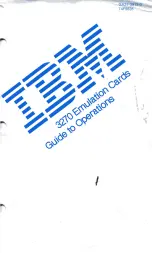
220
CHAPTER 15 WILD REGISTER
15.1
Overview of Wild Register
The wild register function can be used to patch the program which has the bugs by
specifying the addresses and substitute data in internal registers. The primary purpose
of this register is to substitute ROM code in the ROM space. The wild register consists
of 3-byte data setting registers, 3-byte upper address setting registers, 3-byte lower
address setting registers, a 1-byte address compare enable register, and a 1-byte data
test register. The wild register function is described below.
■
Wild Register Function
The wild register consists of three data setting registers, three upper address setting registers, three lower
address setting registers, a 1-byte address compare enable register, and a 1-byte data test register. You can
substitute new data at specific addresses by specifying the addresses and data in these registers. Up to three
bytes of data can be set in the three data setting registers. Similarly, up to three different addresses can be
set
in the three upper and lower address setting registers.
You can use the wild register function to substitute ROM code anywhere in the ROM space. This can be
used for program debugging after creating the mask or to patch bugs in the program. This is done by setting
up the wild registers from an external device via the communication bus.
Summary of Contents for F2 MC-8FX Family
Page 2: ......
Page 4: ......
Page 34: ...20 CHAPTER 1 DESCRIPTION ...
Page 38: ...24 CHAPTER 2 HANDLING DEVICES ...
Page 39: ...25 CHAPTER 3 MEMORY SPACE This chapter describes memory space 3 1 Memory Space 3 2 Memory Map ...
Page 56: ...42 CHAPTER 5 CPU ...
Page 73: ...59 CHAPTER 6 CLOCK CONTROLLER ...
Page 96: ...82 CHAPTER 6 CLOCK CONTROLLER ...
Page 104: ...90 CHAPTER 7 RESET ...
Page 105: ...91 CHAPTER 8 INTERRUPTS This chapter explains the interrupts 8 1 Interrupts ...
Page 174: ...160 CHAPTER 10 TIMEBASE TIMER ...
Page 184: ...170 CHAPTER 10 TIMEBASE TIMER ...
Page 218: ...204 CHAPTER 13 WATCH PRESCALER ...
Page 257: ...243 CHAPTER 16 8 16 BIT COMPOSITE TIMER ...
Page 261: ...247 CHAPTER 16 8 16 BIT COMPOSITE TIMER ...
Page 288: ...274 CHAPTER 16 8 16 BIT COMPOSITE TIMER ...
Page 301: ...287 CHAPTER 17 16 BIT PPG TIMER ...
Page 316: ...302 CHAPTER 17 16 BIT PPG TIMER ...
Page 382: ...368 CHAPTER 21 UART SIO DEDICATED BAUD RATE GENERATOR ...
Page 390: ...376 CHAPTER 22 I2C ...
Page 395: ...381 CHAPTER 22 I2C ...
Page 399: ...385 CHAPTER 22 I2C ...
Page 430: ...416 CHAPTER 23 10 BIT A D CONVERTER ...
Page 476: ...462 CHAPTER 24 LCD CONTROLLER ...
Page 482: ...468 CHAPTER 25 LOW VOLTAGE DETECTION RESET CIRCUIT ...
Page 494: ...480 CHAPTER 26 CLOCK SUPERVISOR ...
Page 507: ...493 CHAPTER 27 REAL TIME CLOCK ...
Page 523: ...509 CHAPTER 27 REAL TIME CLOCK ...
Page 532: ...518 CHAPTER 27 REAL TIME CLOCK ...
Page 536: ...522 CHAPTER 28 256 KBIT FLASH MEMORY ...
Page 554: ...540 CHAPTER 28 256 KBIT FLASH MEMORY ...
Page 564: ...550 CHAPTER 29 EXAMPLE OF SERIAL PROGRAMMING CONNECTION ...
Page 595: ...581 INDEX INDEX The index follows on the next page This is listed in alphabetic order ...
Page 596: ...582 INDEX Index ...
Page 597: ...583 INDEX ...
Page 600: ...586 Pin Function Index ...
Page 602: ......
















































